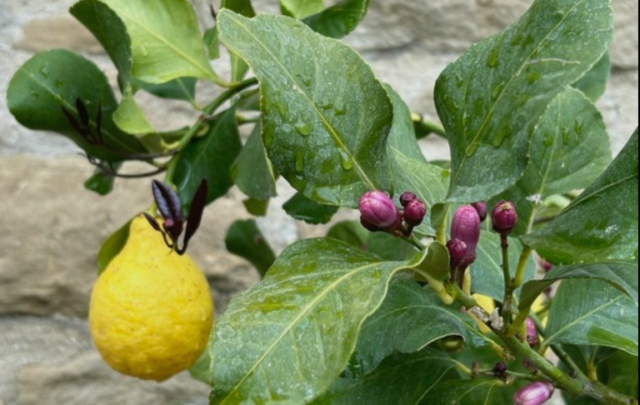Click on the headline (link) for the full text.
Water Works
Cynthia Barnett, Orion
ON A WINTER’S DAY in Seattle, a leaden monotony hangs over the Central Business District, dispiriting to this part of downtown. Contrary to reputation, the urban pallor is not born of rain, which falls almost imperceptibly from silvery clouds that match the nearby waters of Puget Sound. Rather, the gloom rises from the cement hardscape. The busy streets are paved dark gray, the wide sidewalks beside them light gray. The skyscrapers rise in shades of gray. The hulking freeways, ramps, and overpasses: gray. The monorail track and its elephantine pillars: gray.
Trudge the sidewalks northwest to Seattle’s Belltown neighborhood, hang a left on Vine Street toward the sound, and a ten-foot-tall, bright blue rain tank pops from the dullness, tipped whimsically toward a red brick office building. Atop the tank, green pipes in the shape of fingers and a thumb reach out, the stretched index finger connected to a downspout from the rooftop. Rainwater flows from roof to finger to palm to thumb, from which it pours to a series of descending basins built between the sidewalk and the street. They, in turn, cascade to landscaped wedges growing thick with woodland plants. For two blocks, as Vine slopes toward the sound, water trickles down a runnel and through street-side planters, shining stones, and stepped terraces, enlivening the roadway with greenery, public sculpture, and the sounds of falling water.
The project, called Growing Vine Street, began as a small, grassroots effort among residents and property owners to turn their stretch of a former industrial neighborhood into an urban watershed. Twenty years later, it is a big part of the answer to the largest single source of pollution fouling Puget Sound and most of the major bays and freshwater ecosystems of the United States—stormwater.
The gray shellac of a city repels more than the imagination. When rain flows along streets, parking lots, and rooftops rather than percolating into the ground, it soaks up toxic metals, oil and grease, pesticides and herbicides, feces, and every other scourge that can make its way to a gutter…
Returning some of nature’s hydrology to the cityscape can make an enormous difference —or could—as more individuals, businesses, and neighborhoods remake their bit of the terra firma. Washington State University scientists have found that streets with rain gardens clean up 90 percent or more of the pollutants flowing through on their way to the sound…
In the parlance of water professionals, projects like Growing Vine Street are known as “green infrastructure.” But the term does not do justice to the larger water revolution it represents. Across the nation, antiquated infrastructure like Seattle’s, swelling populations, and weather extremes are stressing our triplicate freshwater, stormwater, and wastewater systems like never before. Industry groups such as the American Society of Civil Engineers, American Water Works Association, National Association of Water Companies, and U.S. Chamber of Commerce repeat the mantra that the nation’s water systems are some of the oldest, most overused, and most seriously failing of all America’s infrastructure—worse off than the nation’s bridges. The EPA estimates that repairing, replacing, and upgrading these aging water systems will cost between $300 billion and $1 trillion over the next two decades…
IN 1878, a sanitary engineer named George E. Waring Jr. ranted in The American Architect about the nation’s sudden craze for faucets on every bowl and washbasin. The demand for freshwater pipes coming into homes, waste pipes going out, and the luxury of hot and cold was so intense, plumbers were rushing jobs, busting pipes, and causing boiler accidents, in some cases scaring homeowners back to sponge baths.
“In our desire to save labor so far as possible, to procure in our houses the luxury of abundant water without the task of carrying it in and out by hand, and to provide, even for those classes of society which are little given to luxuries, the untold convenience of a free tap of water at every point, we have carried the possibilities of the industry to its utmost limit,” he warned…
SEATTLE WAS AMONG the first major American cities to accept that it had hit the limit. The Emerald City taps a clear mountain river called the Cedar, and a smaller river, the Tolt, to quench the thirst of 1.4 million urbanites and corporate giants from Amazon to Microsoft. The Cedar River begins in the cloud-laced foothills of the Cascade Range, flows forty-five miles south to Seattle’s iconic Lake Washington, and ultimately to Puget Sound. Seattle’s leaders had the foresight to begin buying up the river’s watershed for drinking water in the late 1800s; over a century, they’d preserved more than ninety thousand acres. At the upper reaches of the watershed, snowpack collects in winter, then fills the city’s reservoirs for the dry summer. At the lower end, the Landsburg Dam diverts the river for drinking water.
Beginning in the 1960s, Seattle Public Utilities (SPU) officials were convinced the system could not meet the demands of a fast-growing population that, like most of America, used water as if it were abundant as air. While many cities faced one water anxiety or another—dwindling supply, looming infrastructure costs, flooding, sewage and stormwater overflows—Seattle, its original waterworks so old it had been built with wooden stave pipes, faced all of those and more…
Audio slideshow of Next-Gen Water Infrastructure
(July/August 2013)
New Mexico is the driest of the dry
Julie Cart, LA Times
Scientists in the West have a particular way of walking a landscape and divining its secrets: They kick a toe into loamy soil or drag a boot heel across the desert’s crust, leaning down to squint at the tiny excavation.
Try that maneuver in New Mexico these days and it yields nothing but bad news in a puff of dust.
Across the West, changes in the climate are taking a toll. Almost 87% of the region is in a drought.
Nevada is removing wild horses and stocks of cattle from federal rangelands, Wyoming is seeding clouds as part of a long-term "weather modification program," officials in Colorado say the state’s southeastern plains are experiencing Dust Bowl conditions, and the entire western U.S. has been beset by more frequent and ferocious wildfires across an ever-more combustible landscape.
But nowhere is it worse than in New Mexico. In this parched state, the question is no longer how much worse it can get but whether it will ever get better — and, ominously, whether collapsing ecosystems can recover even if it does…
(6 August 2013)
Water shortages loom in Southwest, could trigger cuts
Bob Berwyn, MSN News
Water levels in the Colorado River Basin could drop to levels that require cutting water deliveries to California, Arizona and Nevada.
Resource managers in the Colorado River Basin are preparing for an unprecedented scenario: By next year, water in Lake Powell is likely to drop to a level that will trigger mandatory cuts in water deliveries to California, Arizona and Nevada.
The U.S. Bureau of Reclamation will release a 24-month projection for Lake Powell storage levels in early August. Those numbers will help determine whether cutbacks kick in, but some water managers in the basin are already preparing for the worst…
(3 August 2013)
Wells Are Running Dry In Parts Of Kansas
Frank Morris, All Things Considered – npr
Imagine enough water to fill a couple of Great Lakes, but spread under some of the driest parts of eight Western states. That was the High Plains Aquifer 60 years ago.
But now, Nate Pike, whose been riding the dry rolling ranch lands south of Dodge City, Kan., for most of his 80 years, can’t even go fishing at his favorite spring called St. Jacob’s Well.
“And that thing had a lot of water in it. It never went down, never changed,” he says. “But as you can see now, I can’t believe I can’t see the water from up here.”
Pike blames it on new pumping and irrigation systems. These tools made it easy for farmers to extract billions of gallons from it, and use it to grow lucrative crops on the arid land. An agricultural gold rush of sorts followed, transforming the regional economy, but also drying up wells…
Listen
(6 August 2013)
Dripping faucet image via shutterstock. Reproduced at Resilience.org with permission.






